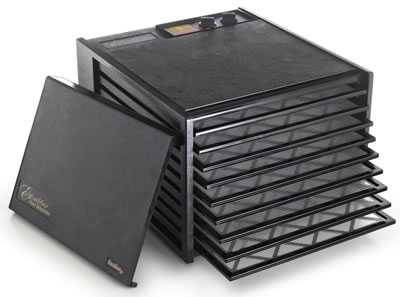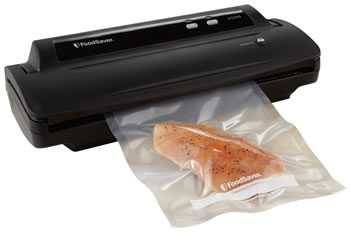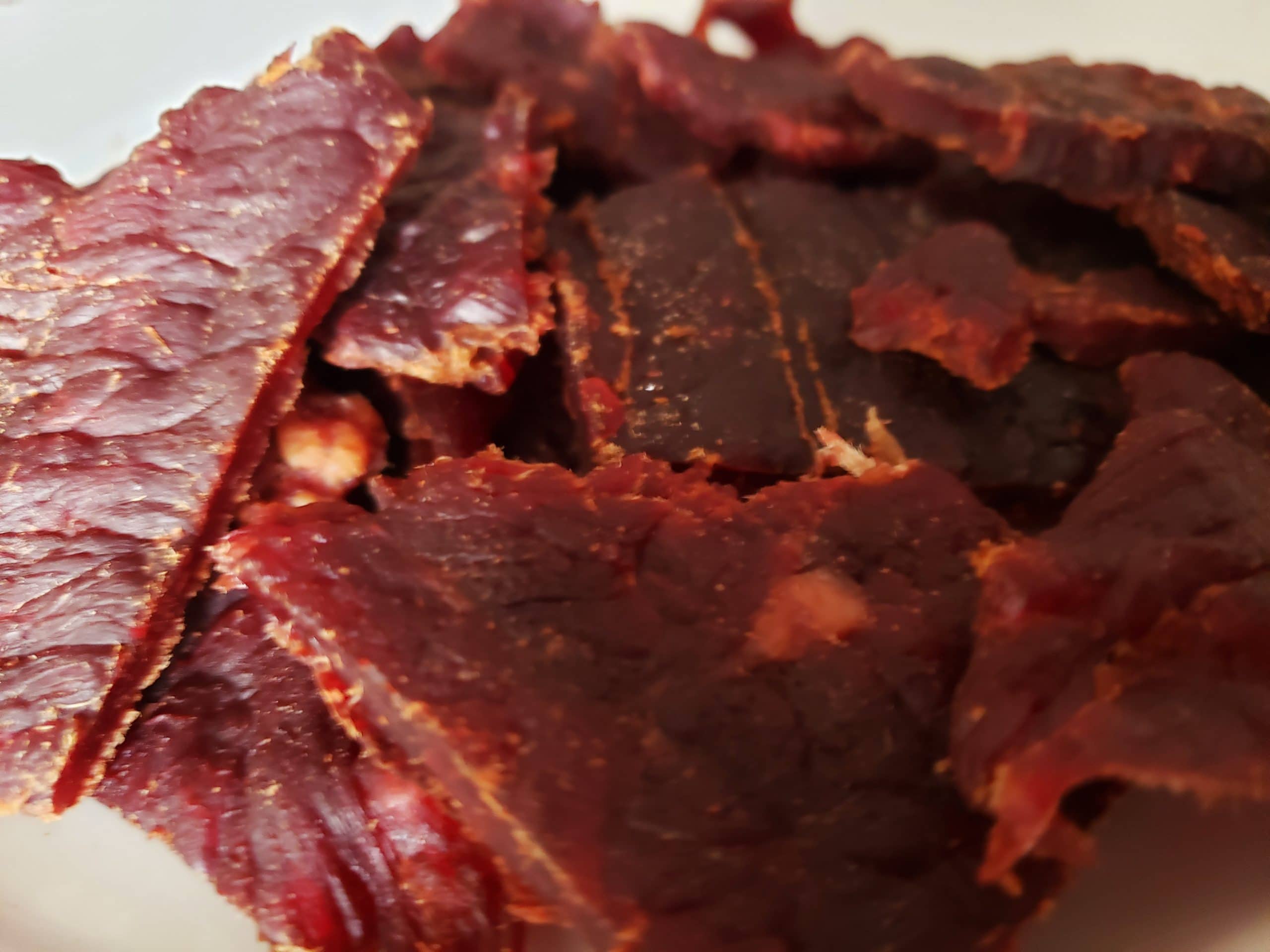Store bought beef jerky is OK but this home made version puts even the best brands to shame.
Serve with: a stout or porter.
Makes:
Servings: 1-ounce (28.3 g) servings
Takes:
Ingredients
- 2 pounds eye of round beef
- 1 cup soy sauce
- 1/2 cup molasses, honey, or sorghum
- 1/4 cup Bourbon, Scotch, dark rum, brandy, or other dark whiskey
- 1 knob of fresh ginger
- 3 tablespoons Kansas City style barbecue sauce
- 3 tablespoons Meathead's Memphis Dust
- 2 teaspoons Morton Coarse Kosher Salt
- 1 tablespoon hot sauce
Notes:
About the beef. Since fat will not dehydrate and it gets funky with age, the best meats are lean muscles that are well trimmed. I recommend eye of round, top round, or bottom round. I am told that or flank steak and lean brisket from the flat section are also good, but I have not used them. Do not use ground beef. Pick something that is on sale. This is also a great use for hunks of meat that have been in the freezer a long time. When they defrost they tend to give up a lot of moisture and are therefore less desirable than fresh meat. Jerky is a great use for them.
Other meats. Turkey breasts are good for making jerky. Rabbit loin and lean cuts from venison, elk, antelope, deer, caribou, moose, and buffalo also work very well. Bear is too greasy my hunter friends say. The Oregon State University Extension Service says game meats should be frozen for at least 60 days at 0°F (-17.8°C) to kill parasites.
About the soy sauce. Soy sauce is the salt source in this recipe and it is important as a microbial inhibitor. Make sure it is more than half the contents of your marinade. Get a good fermented soy sauce like Kikkoman.
About the liquor. None of the alcohol will remain in the meat after drying. Alcohol evaporates at a lower temp than water. But it does add oaky flavor, especially if you dry the meat indoors or without smoke. The alcohol helps pull moisture from the meat, however, and this is good.
About the salt. Remember, kosher salt is half the concentration of table salt so if you use table salt, use half as much. Click here to read more about salt and how it works.
About the ginger. Please DO NOT skimp on the ginger and DO NOT substitute ginger powder. It really ads to this recipe.
Optional. If you can't smoke it, you might want to add 1 tablespoon of liquid smoke. Worcestershire is another popular addition.
Metric conversion:
These recipes were created in US Customary measurements and the conversion to metric is being done by calculations. They should be accurate, but it is possible there could be an error. If you find one, please let us know in the comments at the bottom of the page
Method
- Prep. Peel and grate enough ginger to create 5 tablespoons.
- To slice the beef, begin by putting the meat in the freezer for an hour or two to stiffen it and make it easier to cut. Cut the meat in disks about 1/8 to 1/4" (3.2 to 6.4 mm) thick. Strive to make them uniform in thickness. You don't want them paper thin because they will shrink in half, but you don't want it too thick or it will take forever to dry. I like to cut across the grain to make it less chewy. Some folks cut with the grain to give their mandibles more of a workout. They won't be long strips like bacon. Odd shapes are good. They tell people that it is home made. Put the meat a 1 gallon (3.8 L) zipper bag.
- Marinate. Mix the marinade by whisking all the ingredients together. Pour it into the zipper bag. Put the bag in a bowl or pan in the refrigerator to catch any leaks. Let the marinade make love to the meat all night long at least. Occasionally pick up the bag and roll it around massaging it for several minutes to make sure the liquid is contacting all the meat surfaces. This is important. It can stay in the marinade for up to 2 days if you wish. When you are ready to cook, drain the meat in a colander and discard the marinade. Do not save it for another day.
- Fire up. After the meat is done marinating, set up your grill for 2-zone indirect cooking shooting for about 200°F (93.3°C) in the indirect zone. Get that wood right on the heat source to make sure it smokes. On a gas grill you will want to put it in an aluminum foil packet and poke holes in it. If you wish, you can prop open the lid of your cooker to let heat escape in order to keep the cooking temp down. This will also increase air flow. If you normally use a water pan, skip it today. The goal is dehydration not moisturizing.
- Cook. Spread the meat on a grill grate or a grill topper. I am a big fan of the non-stick narrow mesh Frogmats do the job, especially since they can be cleaned in the dishwasher. Make sure the meat is not folded over on itself or overlapping. You can use both lower and upper grates if your setup allows. Smoke for about 15 to 60 minutes. That'll kill the bugs and add smoke flavor. If you are using a grill and the heat is on one side, then you may need to rotate the meat so the stuff on the cooler side goes to the hot side after about 30 minutes. This will get the center of the meat up past the kill zone and start the dehydration. Keep an eye on it during the cooking process so it doesn't get too dry.Jerky elitists don't like the idea of cooking the meat, but it is absolutely necessary to make the meat safe if you are not using a preservative and even then, cold smoking is risky and I cannot recommend it for home cooks. Smoke is not necessary, but it adds a pleasing BBQ flavor and improves shelf life in the fridge. A good digital oven thermometer is important for this phase unless you've been hankering to get up close and personal with Salmonella, E. coli O157:H7, and Listeria monocytogenes. You cannot trust your grill's bi-metal dial thermometer. It can be off by as much as 50°F (10°C). Click here for the USDA guidelines for commercial jerky production.
- Dehydrate. The final step is dehydration. You can stop smoking and cooking and dry the meat to jerky consistency. That means dark, almost black, but not carbonized, pliable but breakable, but not so brittle that it shatters. Drop the cooker's air temp to no lower than 140°F (60°C) and hold it there. If you have an indoor kitchen dehydrator, you can move the meat there at this stage. They are great because they have a fan and that can reduce drying time to less than 6 hours. I have an article about electric dehydrators here. Or you can put it in your oven, just leave the door cracked open a bit. Drying on a grill or in the oven can take as long as 12 to 18 hours depending on the temp and how thick the meat is. It is hard to get a grill or smoker or even indoor oven down to 140°F (60°C), so just get as low as you can. If you need to, you can leave the lid or door partially open to dissipate the heat. The hotter it is the crunchier the meat will get, but you want a balance between crunchy and chewy. You want jerky, not hard candy.

- During the process, the meat will start out tan in color, progress through rosy, and eventually blacken. But it is not really black. It is just really really dark. You want to remove it right after the last bit of rose color disappears. But that's my preference. It will also lose about half it's weight. As it starts to go, start tasting. Learn what texture you like best. This might require a lot of tasting. And beer. And friends to offer their opinions.
- Serve. Enjoy immediately or store for later. The drier it gets, the longer it keeps. How long? If you have been careful about cleanliness and hit the temperature guidelines above (this is especially important for game), USDA says it can be stored safely a month or two at room temperature. I use a vacuum sealer and keep mine in the fridge just to be sure. And yes, it can be frozen.

